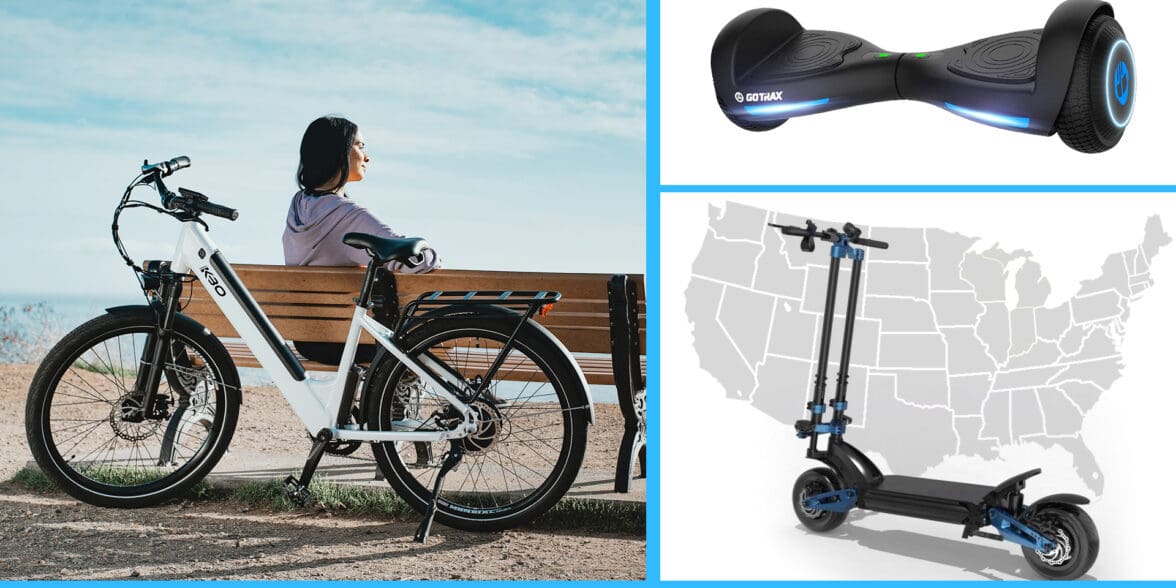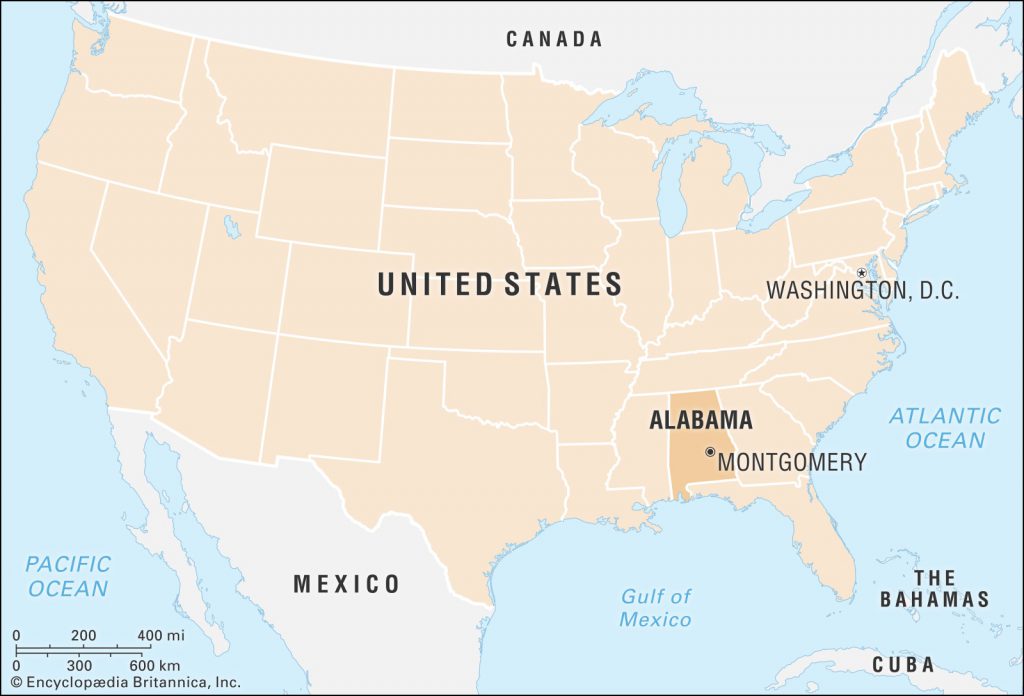In this guide, we aim to clarify any misconceptions surrounding PEV and eBike law in the US. With PEVs exploding with popularity worldwide, we found it no surprise that the US is also seeing a massive increase in electric vehicle use. However, this eco-rider revolution is all still very new to the public, which can lead to misunderstandings and unlawful riding.
As such, we will cover the rules, regulations and requirements to ride hoverboards, eScooters, eBikes and electric skateboards legally, across all states. Thankfully for convenience’s sake, 26 states have already adopted a three-tiered classification for electric bikes, covered below.
Please note that many states allow cities, towns and other municipalities to create their own local regulations for PLEV models, provided they stay consistent with state law.
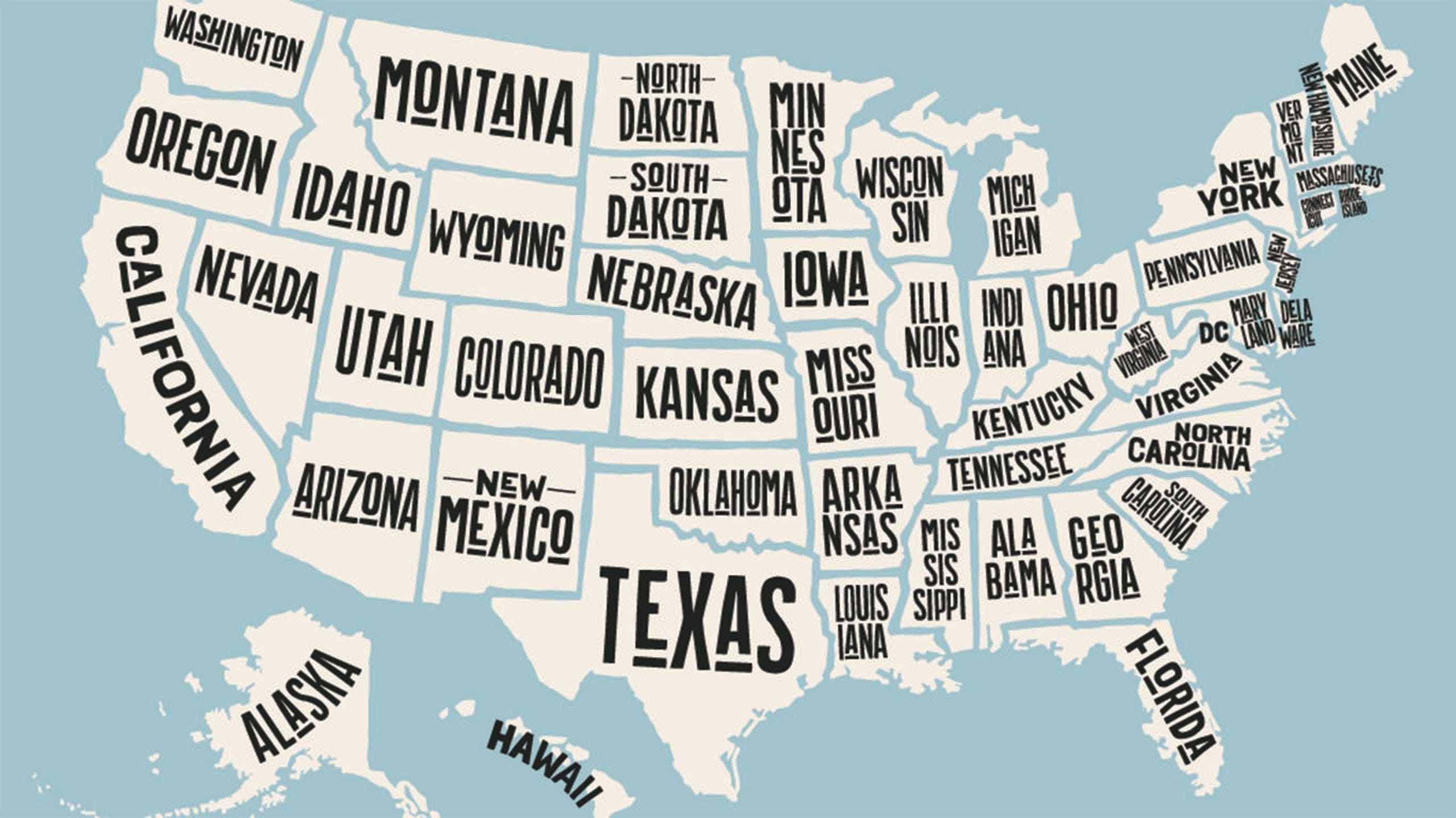
Three-Tier eBike Classification Explained
Class 1 eBikes
Models are classified at this level when they have a top speed of 20 mp/h, coupled with a motor that only functions with pedal assist.
Class 2 eBikes
Models of this class come equipped with a throttle activated motor, which must stop assisting after reaching 20 mp/h.
Class 3 eBikes
eBike models of this classification reach speeds of up to 28 mp/h, before the motor stops assisting. Sometimes known as pedelec bikes, this remains the most restricted class of eBike. In some states, further safety restrictions are placed on these models.
Currently, 18 states classify eBikes within their own parameters, with a further 11 states having no official definition for such PEVs. The rules for electric scooters seem to vary depending on the state. US2002 Federal Law dictates that eScooters are legal for use on roads that lack bicycle lanes and operate within a 25 mp/h speed limit. It also classifies eBikes with motors operating below 750W and a top speed under 20mp/h as “street legal”; meaning that no registration or licensing is required to ride.
Electric bikes and scooters are classified as Personal Light Electric Vehicles (PLEV). As for hoverboards, these types of PLEV still remain legal throughout the U.S, with California being one of the first to regulate such models. However, not every region shares this sentiment. So with that in mind, let’s begin the bulk of our guide to PEV and eBike law in the U.S, from state to state.
“Three-Tier” States
Here are all of the states that share the same “three-tier” classifications for electric bikes, alongside their laws surrounding other PLEV types. This means that electric bike models fitting within these parameters remain regulated like traditional bicycles. Currently, only six states allow PLEV models with a max. power of 1000W+.
These states are Georgia, Arkansas, Minnesota, Oklahoma, Oregon and Virginia; with Florida and Mississippi possessing no power limit for eBikes. On the other hand, the following 26 states all maintain the same rules and requirements for eBikes, helping follow a uniform approach in regulation. Learn more about which states adopt this method and the rules on other PLEV models below:
Alabama PEV Laws
Minimum age: 14+
Helmet required for all classes and ages.
eBikes: Legal (Class B license).
eBikes in Alabama are still classified as motor-driven vehicles, with riders required to apply for a “B” restricted motorcycle license. Despite this, no restrictions on motor or throttle power are mentioned.
eScooters: Legal (Class M license).
For electric scooters, a “Class M” license is required and restricted to those aged 14 and above. Such riders must also wear a helmet at all times, as eScooters fall under the same definition as eBikes.
Hoverboards: Legal (Sidewalk only).
eBoards: Legal.
These PLEVs are currently restricted to use on the sidewalk only. Under Section 10-1-2. of the Alabama Code of Ordinances, no person upon roller skates or any other coaster has access to the roadway.
 Alaska PEV Laws
Alaska PEV Laws
Minimum age: Unspecified.
No helmet requirements.
eBikes: Limited.
Defined as a “motor-driven cycle”, riders must first possess valid licensing and registration before using their eBike. Despite this, these PLEV models remain banned from sidewalks and bike paths, instead having to stick to the road. They’re also still limited to a maximum motor output of 750W. View this post for more information on eBikes in Alaska.
eScooters: Limited.
Under Alaska Statute 28.90.990, any motorised vehicle not 100% ‘human-powered’ cannot be considered a bicycle, instead viewed as a scooter or moped. As such, they remain prohibited from sidewalks, bike paths and recreational trails, even requiring an ‘M2 Class‘ license to operate legally.
Hoverboards:
‘Clause 12’ of Alaska Statute 28.90.990 also defines “electric personal motor vehicles”, making an exception for “Segway-style” models. This essentially means that the hoverboard model must fit within EPMV guidelines:
- Operating no faster than 15 mp/h
- Transporting one person
- Self-balancing with two non-tandem wheels
- Incorporates an electric propulsion system.
We always recommend checking your local municipal laws first before riding.
eBoards: Unspecified
Currently unregulated. Must adhere to Clause 12’s ‘EPMV’ definition (detailed above) in order to legally operate.

Arkansas PEV Laws
Minimum age: 16+
Helmet required for Class 3 riders under 21 years old.
eBikes: Legal.
Currently, both Class 1-2 eBikes may go wherever regular bicycles can, whilst Class 3 models only legally see use on roadways. Interestingly, Arkansas law does not require bicycles to possess braking capabilities.
eScooters: Legal under “Electric Motorized Scooter Act” of 2019.
These models must weigh under 100 lbs (45 kg) and not reach speeds of over 20 mp/h; although riders must be 16+ and are not allowed to ride any faster than just 15 mp/h.
Hoverboards: Unspecified.
eBoards: Legal.
These PLEV models remain exempt from both regulation and licensure, classified as a “speciality vehicle”.
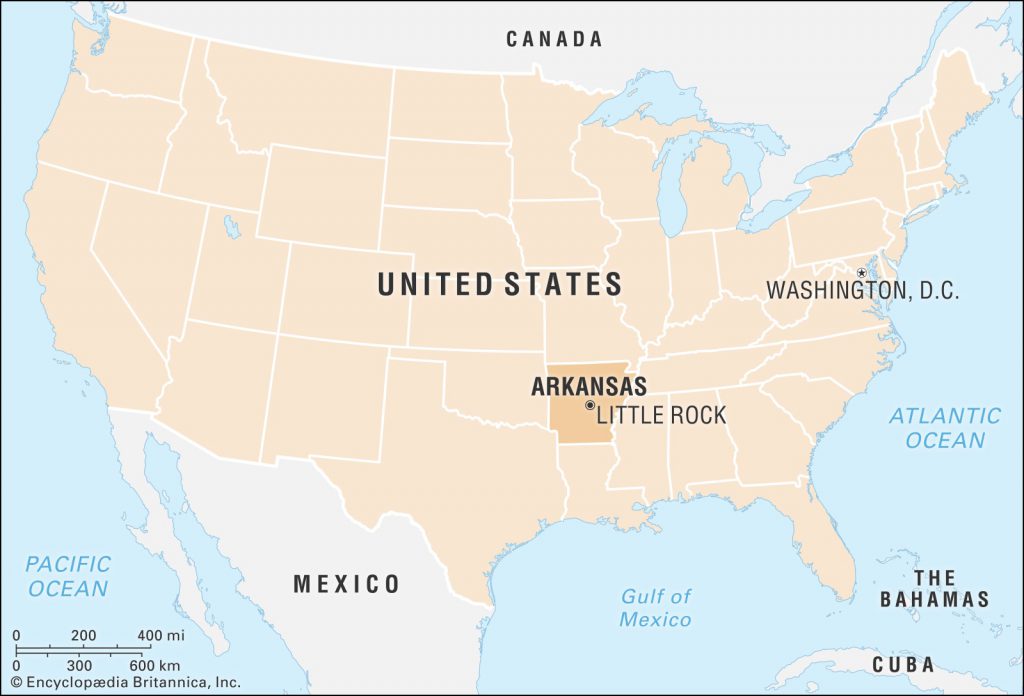
Arizona PEV Laws
Minimum age: Unspecified.
No helmet requirements.
eBikes: Legal.
Despite following the three-tier system, electric bikes are limited to a top speed of 25 mp/h. Furthermore, no licensing, insurance, registration or even a helmet is required. It seems that Arizona definitely needs to update its eBike regulation soon!
eScooters: Legal.
Any motorized scooter with handlebars that weighs less than 75 lbs and cannot exceed 25 mp/h are treated the same as bicycles/eBikes; with no licensing, registration or insurance required.
eBoards/Hoverboards: Restricted.
Laws and regulations vary depending on the municipality. For example, Phoenix City Council recently banned all motorized skateboards, scooters and hoverboards from operating on all public rights of way. This essentially means that riders can legally only operate such PLEV models on private property.

California PEV Laws
Minimum age:16+.
Whilst we found no mention of age limitation for Class 1 and 2 eBikes, Class 3 models must require a rider age of at least 16+ years old. These Class 3 eBikes also cannot operate on Class 1 bicycle paths and must wear a helmet, regardless of age.
eBikes: Legal, follows “three-tier” classifications.
Riders do not require any licensing, insurance or registration to ride these PLEV models. Riders aged 17 or under must wear a helmet at all times when riding, with those aged 18+ not required to do so. Riding on the sidewalk is only allowed if done so by regular bicycles, putting most downtown areas out of the question.
eScooters: Legal.
Riders can operate their scooter with any class of license, with a regular driver’s license being the bare minimum. Whilst these models are street legal, no registration or insurance is required to ride these PLEVs. These eScooter models may operate on streets, with a maximum speed limit of 25 mp/h. Currently, the only time such eScooters may use the sidewalk is for parking.
Hoverboards: Legal.
One of the first states to officially regulate hoverboards, California passed Assembly Bill No. 604 in 2016. This requires riders to be 16+ years old, remain sober and wear adequate safety gear, such as a helmet. Hoverboards are restricted to roads with a speed limit of 35 mp/h and under, lowered to 15 mp/h on public paths, bikeways and trails. These models must have a fixed lamp either integrated or externally attached when riding at night. Riders who do not follow these laws may find themselves subject to fines.
eBoards: Legal.
The recently passed “AB-604” makes it legal to own and ride eBoards throughout the state, provided the model aligns with regulation. Riders must wear a helmet, remain sober at all times and be at least 16+ years old. Such PLEVs may not travel on highways or exceed speeds over 20 mp/h, with an average power of 1000W or less. Those riding on public property are restricted to 15 mp/h, much like hoverboards. Side/rear reflectors and white headlighting is required when riding at night, either attached to the board or rider.

Colorado PEV Laws
Minimum age: 16+
Helmet required for ‘Class 3’ riders under 21.
eBikes: Legal, follows “three-tier” classifications.
Notable differences include the ability to ride on pedestrian paths, excluding Class 3 models, which may only use designated roadways and bike lanes.
eScooters: Legal.
Prior to the recently passed “HB19-1221 law”, eScooters were classified as “toy vehicles” and only operated on sidewalks. However, now they are seen as motor vehicles and must use both the road and bike lanes, remaining prohibited from using the pavement.
Just like electric bikes, eScooters require no licensing, insurance or registration. Local legislation still stands, with Denver only allowing their use in bike lanes and roadways with speed limits of 30 mp/h or less. We recommend checking the local laws and regulations for your region or municipality.
Hoverboards: Restricted.
Hoverboards are still classified as “toy vehicles” and thus, restricted to use on the sidewalk only. These PLEV models are banned in many schools and universities throughout a number of states.
eBoards: Legal.
Under the same HB 19-1221 law, electric skateboards are now treated as motorised vehicles. Models that do not reach speeds of over 20 mp/h (32 km/h) are classified as bicycles and fall under the same limitations.

Connecticut PEV Laws
Minimum age: 15+
Helmet required for Class 1/2 riders under 16. Class 3 eBike riders must wear a helmet, regardless of age.
eBikes: Legal, follows “three-tier” classifications.
Current state law requires everyone to wear a helmet when riding a bike, at all times. Whilst no registration or insurance is required, bikers must hold a valid driver’s license. If the eBike is slower than the maximum speed of the chosen roadway, riders must stay in the right-hand lane or hard shoulder.
eScooters: Legal.
As of October 2019, all manner of PLEVs became legal in Connecticut, including eScooters. Riders may use these vehicles, provided they do not exceed 20 mp/h or operate on pedestrian sidewalks; with no insurance, registration or licensing required to ride. Unlike eBikes, riders under the age of 16 may still use these models.
Hoverboards: Unspecified.
We were unable to find any significant information surrounding the regulation of hoverboards. From what we’ve seen, the following locations prohibit the use of hoverboards on their premises: Quinnipiac, Sacred Heart, Bridgeport, Hartford and New Haven universities.
eBoards: Restricted.
Electric skateboards remain classified as motor vehicles, with state law prohibiting their operation on any highway, unless registered with the DMV (CGS § 14-12). However, eBoards do not meet the statutory requirements for registration and thus, do not qualify. We currently recommend riding these on private land only.
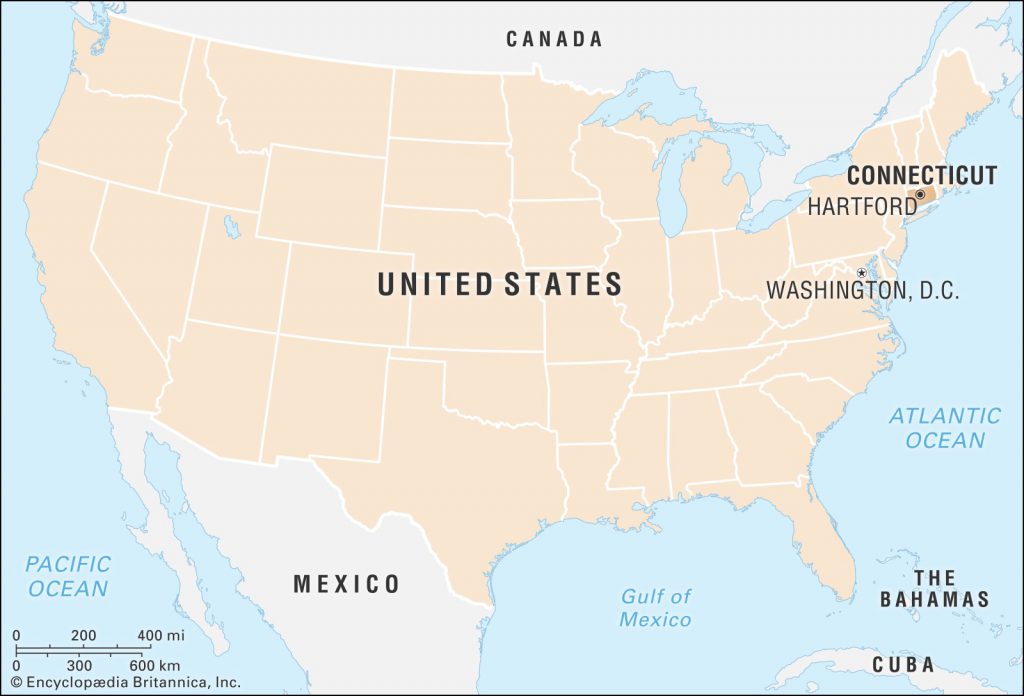
Florida PEV Laws
Minimum age: 16+
Riders under this age must wear a helmet (all classes)
eBikes: Legal, follows “three-tier” classifications.
This state used to consider any eBike to fall under the definition of a bicycle, provided it is capable of operation through human power. However, under House Bill 971, eBikes see regulation through the “three-tier” system. Currently, eBikes have access to roadways, bike paths, trails and even sidewalks. Whilst these laws are fairly liberal, riders may not tamper with or modify their eBike in order to change motor power or speed capabilities. Learn more about Florida eBike law in this document.
eScooters/eBoards: Legal.
Both PLEV models alike see little recognition or even regulation. Under the 2021 Florida Statute, eScooters/eBoards are defined as “motorized personal mobility devices”; in turn limiting them to a maximum output of 750W and a top speed of 20 mp/h. Statute 316.2068 also dictates that these vehicles remain suitable for use on any street, roads and even sidewalks offered to bicycles. Riders must be aged at least 16 years old or over.
Hoverboards: Legal.
Interestingly, Florida is one of few states to legalise the public use of hoverboard models. They do not see classification as motor vehicles and do not require insurance, licensing or registration to ride. Riders also see protection from faulty products through product liability laws.
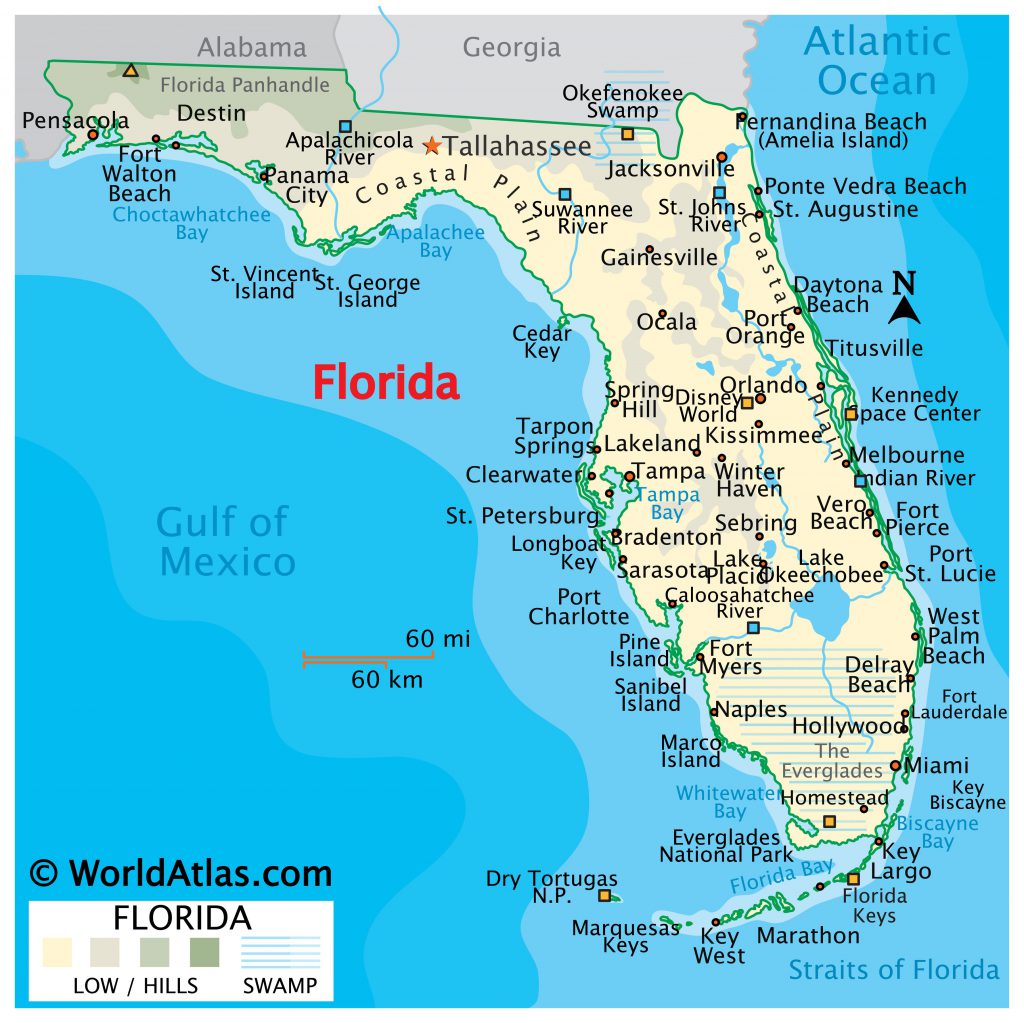
Georgia PEV Laws
Minimum age: Unspecified.
Riders under 16 years old must wear a helmet. Class 3 bike riders of any age must wear a helmet at all times.
eBikes: Legal, follows “three-tier” classifications.
These PLEV models have access to the road, however must stay on a hard shoulder or as far right on the road as possible. Whilst Georgia remains in line with federal regulation, local ordinances may place their own restrictions. Please check the local laws of your region to avoid any discrepancies.
eScooters: Legal.
We’ve found a number of restrictions and requirements regarding eScooters. To begin, riders must own, register and insure their scooter before legally using it. These scooter models must possess a power of more than 50cc, yet less than 350cc. eScooters may find use on bike paths, lanes and roads with a speed limit of 35 mp/h and below. Please note that riders under 16 must wear a helmet throughout their ride.
Hoverboards: Unspecified.
Currently banned from use at the Universities of North Georgia and Columbus State.
eBoards: Unspecified.
There are currently no clearly defined laws regarding eBoards. Referencing Georgia’s low-speed vehicles code, we can consider them either personal assisted mobility devices, or motor-driven cycles. Due to this lack of specification, we recommend checking your local laws and riding only on bike lanes.
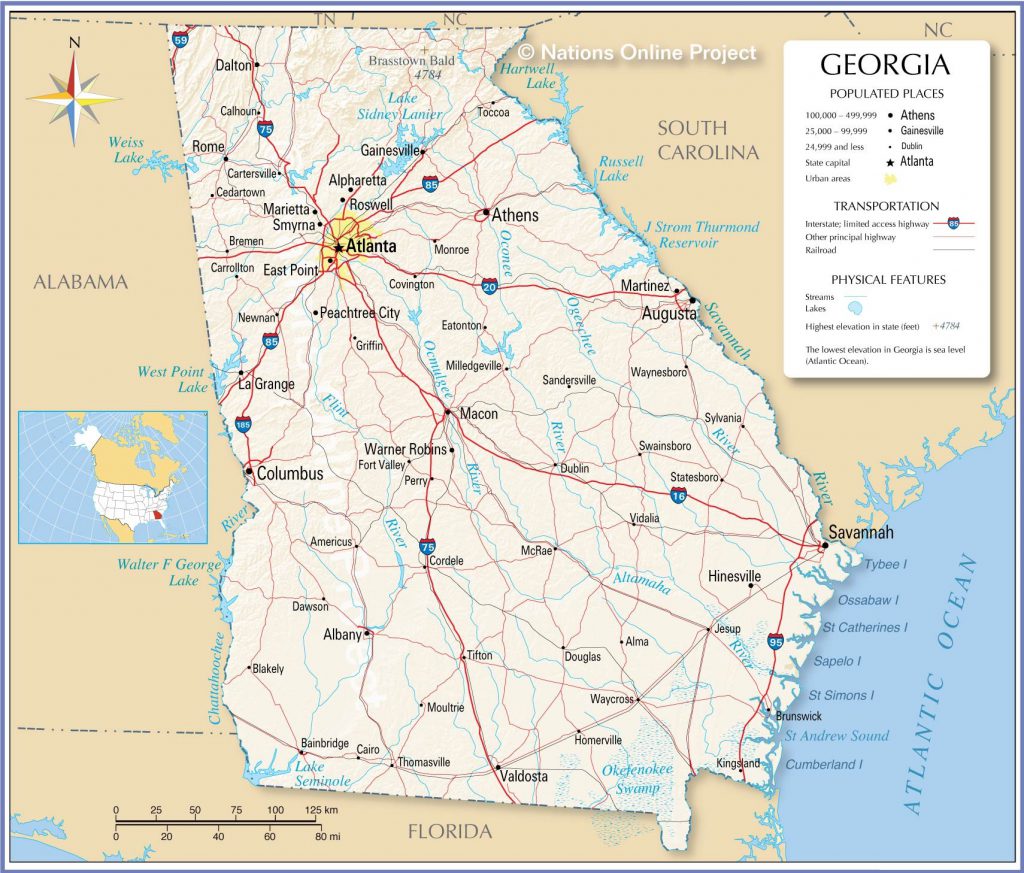
Idaho PEV Laws
Minimum age: 16+
No helmet requirements.
eBikes: Legal, follows “three-tier” classifications.
eBikes are generally used in the same way as traditional bicycles, with Idaho Code 49-106 defining eBikes as an electric motor-driven vehicle, equipped with operable pedals, a saddle and no more than three wheels.
eScooters/eBoards: Unspecified.
Both eScooters and eBoards lack clear legislation or even definitions. As such, they remain classified as motorized cycles and toy vehicles. Whether these models are restricted to the sidewalk remains unspecified.
Hoverboards: Unspecified.
Illinois PEV Laws
Minimum age: 16+
Helmets required for ‘Class 3’ eBike only.
eBikes: Legal, follows “three-tier” classifications.
Riders must not use the sidewalk, sticking to bicycle lanes and the roadside instead. No licensing, registration or insurance is required to ride an eBike in Illinois. Please note that the age restriction only applies to Class 3 models and above. No helmets are required for any PLEV models mentioned on this list.
eScooters: Legal.
Under “HB1590” (Illinois Vehicle Code), a person under 16 may not operate a “low-speed electric scooter”, alongside requiring either a license or permit. Whilst riders can generally use their eScooter on public roads, some local laws may differ on their limitations.
Hoverboards: Unspecified.
Whilst we were unable to find any relevant legislation, hoverboards remain banned on Metra trains and a number of university grounds.
eBoards: Restricted.
Legislation on eBoards is limited. However, it is illegal to ride through city business districts, either on the roads or sidewalks. Other than this, riders are at the mercy of local regulation.

Indiana PEV Laws
Minimum age: 15+
Class 3 eBike only. Helmet required for any rider under the age of 18.
eBikes: Legal, follows “three-tier” classifications.
These models remain regulated the same as traditional bicycles, with no insurance, licensing or registration required.
eScooters: Legal.
Under House Bill 1649, eScooters must:
- Weigh no more than 100 lbs (45.35 kg)
- Travel on no more than three wheels
- Possess an electric motor no faster than 20 mp/h (32 km/h)
- Utilise handlebars and decking accessible to the rider
These models are permitted to use bike lanes, whilst remaining prohibited from sidewalks.
Hoverboards: Legal.
Such PLEV models must be self-balancing with two non-tandem wheels and an electric motor under 750W, resulting in a max. speed of 20mp/h and below. Hoverboards remain banned in a wide number of schools and universities across Indiana.
eBoards: Unspecified.
We recommend following traffic laws and double-checking the regional laws set by your local governing body.
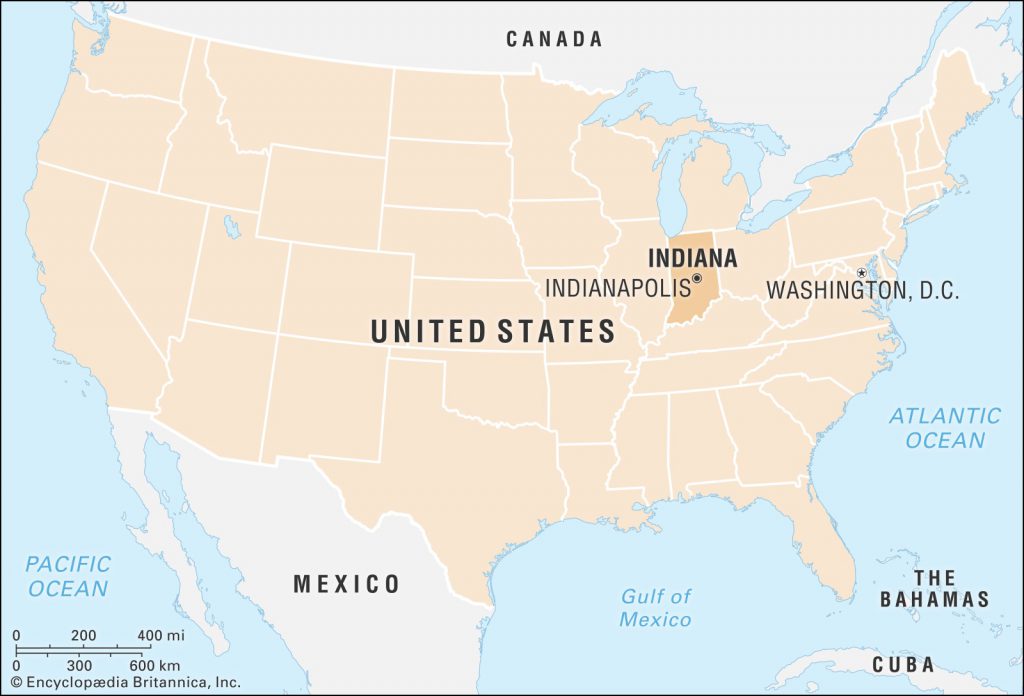
Maryland PEV Laws
Minimum age: Unspecified.
Cyclists under the age of 16 must wear a helmet when riding on public property, extending to all eBike classes.
eBikes: Legal, follows “three-tier” classifications.
Whilst the majority of states have capped eBikes to a maximum power of 750W, Maryland legislation maintains one of the lowest power limits, at just 500W. Despite this stricter regulation, riders still require no licensing or registration.
eScooters: Legal.
Under House Bill 748, these PLEVs fall under the same definition as bicycles; inheriting all the rules and regulations that come with that classification. Riders may not exceed speeds of 20 mp/h (32 km/h).
Hoverboards: Legal.
This state defines hoverboards in the same way as Segways, classifying them as an “Electronic Personal Assistive Mobility Device”, or “EPAMD” for short. These models share the same limitations as Indiana state requirements.
eBoards: Unspecified.
Currently unregulated. Please follow traffic laws and review any rules and regulations put forth by your local governing body.
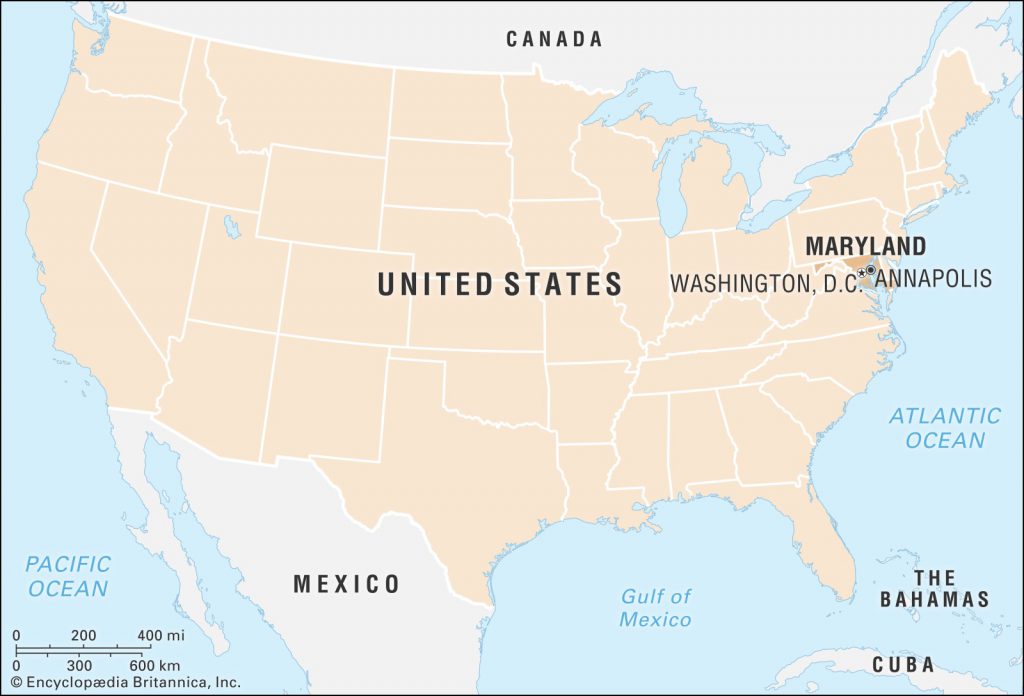
Maine PEV Laws
Minimum age: 16+ (Class 2/3)
Riders under 16 years old must also wear a helmet, regardless of eBike classification.
eBikes: Legal, follows “three-tier” classifications.
Bikers have access to bike lanes and must stick to the right side of roads. Maximum motor output is limited to 750W, for a maximum speed of 20 mp/h on flat surfaces. eBikes must also possess clearly visible white headlights and red tail lights. No drivers license, insurance or legislation is required.
eScooters: Legal.
Much like Maryland, eScooters fall under the same definition as bicycles.
Hoverboards: Legal.
Although not prohibited by federal or state regulation, municipalities may prohibit hoverboards and other such models. As such, we recommend checking your regional laws, set by your local governing body. §2063-A of Maine state law details all of the regulations surrounding EPAMD’s.
eBoards: Unspecified.
Currently unregulated. Please follow traffic laws and review any rules and regulations put forth by your local governing body.
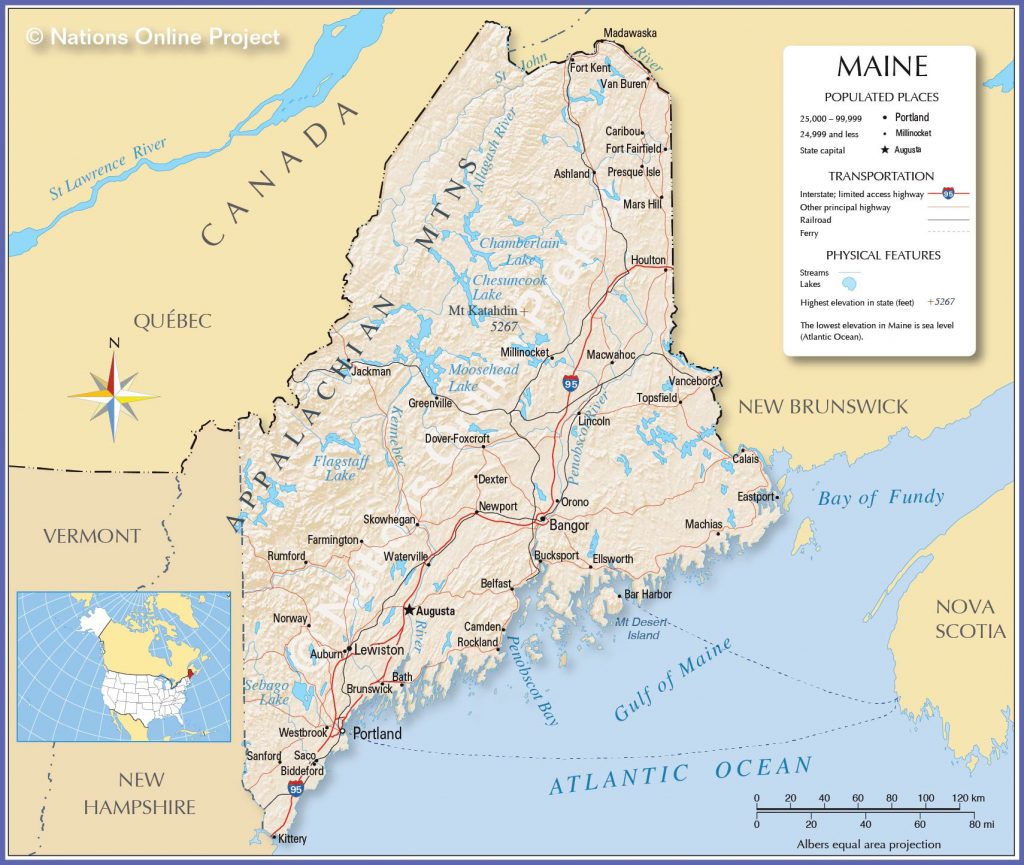
Michigan PEV Laws
Minimum age: 14+ (Class 3 only)
Helmet required for Class 3 riders under 16
eBikes: Legal, follows “three-tier” classifications.
Bikers can ride all three classes on any road used by normal bicycles. No licensing, insurance or registration is required and motors for these eBike models remain capped at 750W.
eScooters/eBoards: Legal
Michigan lists eScooters and eBoards alike under MVC Section 257.13f. This legislation requires these models to possess:
- A maximum speed of 25 mp/h (40 km/h)
- A motor output of no more than 2500W
- Floorboard/deck no more than 60 x 18 inches
- Designed to transport no more than one person
- Functions under human propulsion
These models remain suitable for streets and highways only, maintaining a speed limit of 25 mp/h. Riders must equip front lighting and rear reflectors for use at night, visible from at least 500-600 ft respectively.
Hoverboards: Legal.
Under MCL 251. 13c, hoverboards fall under the same “EPAMD” definition, much like Indiana, Maine and Maryland.

New Hampshire PEV Laws
Minimum age: 16+ (Class 3 only)
Class 1/2: Helmet required for riders under 16.
Class 3: Helmet required for riders under 18.
eBikes: Legal, follows “three-tier” classifications.
Much like many states on this list, no licensing, registration or insurance is required to operate an eBike. All they need to possess are functional pedals and a motor output of less than 750W. Please note that class 3 eBikes cannot use multi-use paths or sidewalks. View the full document of NH bike laws here.
eScooters: Legal.
Riders may only use these models on streets and bike lanes, whenever available. Much like eBkes, use on the sidewalk and other public walkways remain prohibited.
Hoverboards: Unspecified.
We found very little information regarding a statewide stance on hoverboards. The last discussion on this topic was from 2016, discussing exploding batteries. We recommend following the same steps as eBoard riders, detailed below.
eBoards: Unspecified.
Although not regulated, please follow all traffic laws when riding; only after checking your local laws set by your regional governing body.

Missouri PEV Laws
Minimum age: 16+
No helmet requirements. Those under 16 remain prohibited from riding on roadways, as detailed by Missouri State Highway Patrol.
eBikes: Legal.
Seen as ‘motorised bicycles’, eBikes surprisingly still have access to the same roads and highways as bicycles; despite remaining unrecognised under state law. In order to classify as an eBike, the model must possess automatic transmission and a motor output below 750W. Speed limits are a little more lenient than other states, with riders capped at 30 mp/h. No licensing, registration or insurance is required. Learn more about eBike laws in Missouri here.
eScooters: Legal.
Missouri State Highway Patrol also insists that riders possess a valid driver’s license in order to use their eScooter. Riders must also wear a helmet and travel no more than 30 mp/h (48 km/h); or it will see classification as a “motorcycle”, with additional guidelines and rules to follow.
Hoverboards: Limited.
These models fall under the same ‘EPAMD’ definition seen in other states. Chapter 307 of Missouri legislation details this definition, within their specifications. Please note that these laws may be overridden by municipal regulation and other local jurisdictions, so check your local legislation first.
eBoards: Unknown.
We were unable to find any information regarding electric skateboard law in Missouri. Please check your local municipal law to ensure these are not regulated on a regional level.
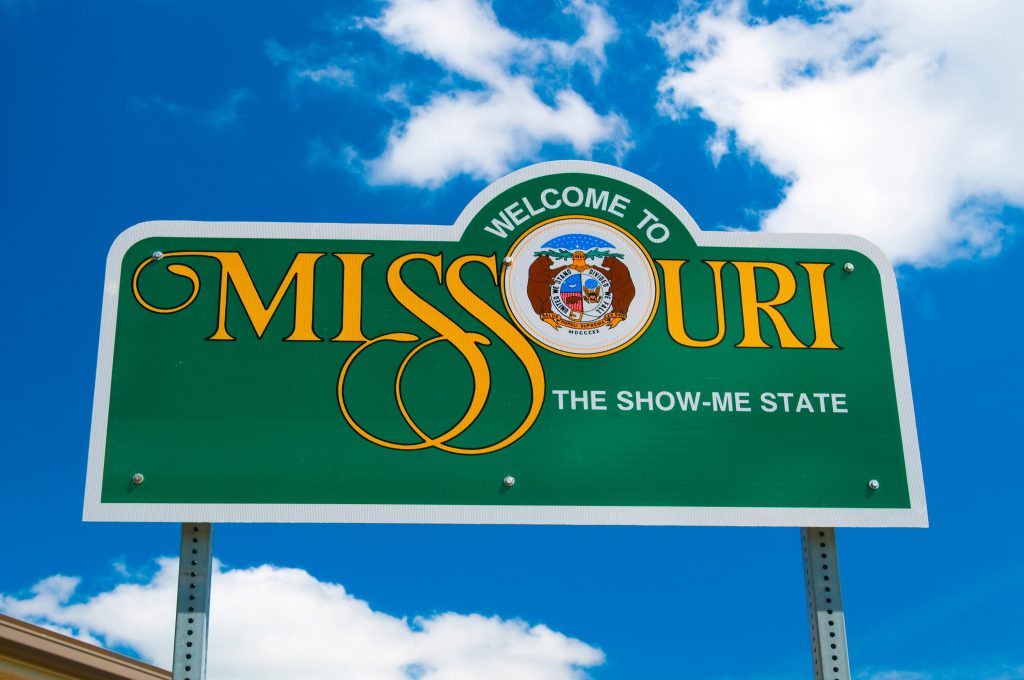
Image Source: ozarksfirst.com
Ohio PEV Laws
Minimum age: 16+ (Class 3 only)
Under Section 4511.522 of Ohio law, those under 16 years old may ride as a passenger on a class 3 eBike. If riding on a class 3 model, bikers of all ages must wear a helmet throughout.
eBikes: Legal, follows “three-tier” classifications.
Regulation for these PLEV models remains in line with the previously covered states. These models must incorporate a speedometer. No registration, licensing or insurance is required.
eScooters: Legal.
eScooters are finally regulated in Ohio, under ‘House Bill 62‘. This bill limits the minimum rider age to at least 16 years old, alongside excluding these models from insurance, licensing and registration requirements. Electric scooters in Ohio may not exceed 15 mp/h (24 km/h), although they remain suitable for use anywhere. Riders must still follow local traffic laws and give way to pedestrians at all times.
Hoverboards: Unspecified.
Although legislation surrounding these models is sparse, a handful of universities within Ohio have outright banned their use. This includes Ohio State, Shawnee State, Case Western Reserve and Findlay universities. Please check your local laws to determine their legality within your region.
eBoards: Unspecified.
These models remain overlooked by Ohio state legislation and instead maintain regulation at a municipal level. With some cities such as Cincinnati banning electric skateboards outright, we advise checking the local laws of your local municipality beforehand.

Oklahoma PEV Laws
Minimum age: 16+, requires any class of license.
Those under the age of 19 must wear a helmet.
eBikes: Legal, follows “three-tier” classifications.
Oklahoma state classifies an electric bike as any bicycle with two or three pedals and a motor with a maximum output below 1000W. Although at least a basic license is required to ride, insurance and registration are not.
eScooters: Legal.
These PLEV models remain regulated on a municipal level. In Oklahoma City, electric scooters remain banned from using sidewalks, with riders required to wear a helmet. However, Tusla city takes a much more relaxed approach, allowing them to operate anywhere except high-pedestrian areas. As such, please check over your local laws before riding!
Hoverboards: Legal.
Hoverboards most likely see classification as ‘EPAMDs’ and follow the appropriate legislation. An OKC Attorney further specifies the legalities behind these models, including whether it’s worth riding drunk (don’t)!
eBoards: Unspecified.
Please note that Oklahoma lacks any statewide laws relating to electric skateboards. It’s highly likely that these boards are currently regulated on a city-wide level only. Please double check your regional laws.
South Dakota PEV Laws
Minimum age: 16+ (Class 3)
Class 1/2: No helmet requirements
Class 3: Helmet required for riders under 18.
eBikes: Legal, follows “three-tier” classifications.
Class 1 and 2 models have full access to both bicycle/multi-use paths; whilst class 3 models must stick to the roadside and hard shoulder. No licensing, registration or insurance is required to operate an eBike in South Dakota.
eScooters: Legal.
South Dakota Law defines eScooters as mopeds; requiring riders to possess a driver’s license or motorcycle permit. This classification results in the restriction of use on sidewalks or highways, alongside requiring insurance. However, registration is not required to operate. Anyone under the age of 18 must wear a helmet when riding.
Hoverboards: Unspecified.
Although these models remain untouched by state legislation, they’re likely classified as ‘EPAMDs’. As such, please check your local laws to see if your region allows for such PLEVs.
eBoards: Unspecified.
Electric skateboards remain unregulated on a state-wide level. Like hoverboards, we encourage riders to check their local laws to assess the legalities of riding in their region.

Tennessee PEV Laws
Minimum age: 16+ (14 with restricted license)
Class 1/2: Helmet required for riders under 16.
Class 3: Helmet required for riders under 18.
eBikes: Legal, follows “three-tier” classifications.
No licensing or registration is required unless riding under the age of 16. All 3 eBike classifications remain limited to a maximum motor output of 750W.
eScooters: Legal
Tennessee state has recently started drafting and enacting legislation for these vehicles. These laws prove a fair bit stricter than their stance on eBikes, requiring an age of at least 18 to ride one and also a valid driver’s license. Read about their introduction here.
Hoverboards: Unspecified.
We were unable to find any regulation surrounding hoverboards. If classified as an ‘EPAMD’, these models will have access to some public rights of way. Moreover, even in the 2019 Tennessee Code Title 55, this remains unspecified. As such, please check your local laws, as they may be regulated on a municipal level.
eBoards: Limited.
Currently, electric skateboards are legislated on a municipal level, with the recent SB1107 Bill looking to amend that. However, we recommend riders wait for this legislation to pass before riding freely. In the meantime, check your local laws to confirm the legalities of your region.

Texas PEV Laws
Minimum age: 15+ (Class 3 only)
Helmet required for riders under 18 years old.
eBikes: Legal, follows “three-tier” classifications.
Class 3 eBikes have access to the majority of roadways and hard-shoulders, including bike paths and trails. No licensing, registration or insurance is required to ride any classification of eBike.
eScooters/eBoards: Limited.
The state classifies both PLEV models as dockless/micro-mobility vehicles. However, local laws still supersede this, with Dallas legalizing eScooters and a number of pilot programs starting soon.
Hoverboards: Unspecified.
Although we found no evidence of hoverboard regulation, there are a number of Segway-based laws. Classified as a “personal assistive mobility device”, models and riders must adhere to these state laws. Learn more about these Segway laws here, discussed by a Dallas attorney.
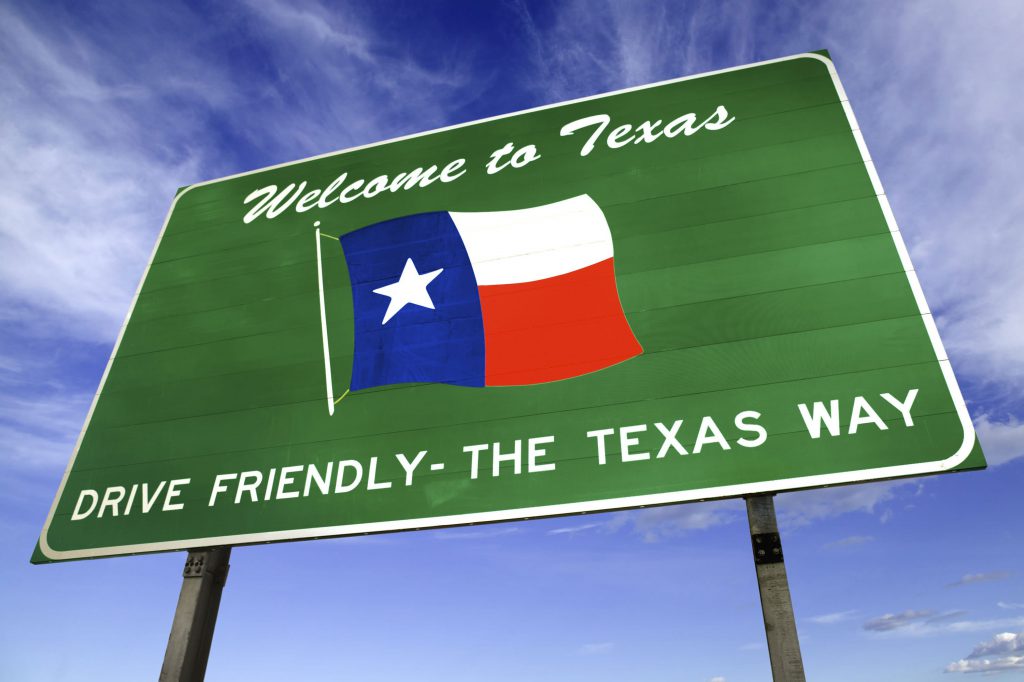
Utah PEV Laws
Minimum age:
Class 1/2: 14+
Class 3: 16+
No helmet requirements.
eBikes: Legal, follows “three-tier” classifications.
All classifications remain regulated the same as a traditional bicycle. As such, these models have access to any trail or path otherwise extended to bicycles. Passengers are not permitted when riding on highways and class 2 eBikes remain subject to Section 41-6a-526. We recommend reading through the Utah Title 41 Motor Vehicle Code for all legislation surrounding PLEVs. Alternatively, read a brief summary of this legislation here.
eScooters: Legal.
In order to meet state classification, eScooters are listed as “motor-assisted scooters”. As such, they must possess:
- A braking system
- A top speed limited to no more than 20 mp/h (32 km/h)
- Capable of travelling via human propulsion
- Two wheels in contact with the ground
- A motor output that never exceeds over 2000W
- Suitable handlebar and deck design for a rider to stand on
Interestingly, the minimum age requirement for riders is 18, despite riders having access to eBikes at just 14. Although differing on respective age limits, these scooters also have access to all the same routes and paths as electric bikes. We recommend reading Utah’s 2019 SB0139 for their complete definition/specification of eScooters.
eBoards/Hoverboards: Unspecified.
Although we found no legislation for either PLEV model, it’s likely that these fall under “EPAMDs”. Currently, eBoard riders should encounter no issues, provided they ride sensibly and follow traffic laws. We still recommend checking your local laws to better understand the regulations of your region.

Virginia PEV Laws
Minimum age: 14+ (Class 3)
Helmet required for all class 3 riders.
eBikes: Legal, follows “three-tier” classifications.
All models must possess a motor power equal to or below 1000W, operating at a maximum speed of 25 mp/h. These models see use on all public roadways and bike lanes with a speed limit under 25 mp/h. Riders require no registration, licensing or insurance to operate these bikes. Should models exceed this, West Virginia defines them as a “moped”, requiring licensing and insurance relevant to motor vehicles.
eScooters/eBoards: Legal.
Under Virginia Code 46.2-908.1, both electric scooters and skateboards see the same regulation. Both models must not exceed 20 mp/h and riders must be over 14 years old or supervised by an adult. Please note, these vehicles remain unsuitable for use on interstate highways. Read about Virginia’s eScooter/eBoard law in greater detail here.
Hoverboards: Legal.
Under § 46.2-908.1 of the Virginia Code, hoverboards are classified as EPAMD’s. As such, they must not exceed speeds of 25 mp/h or see use publicly by riders under the age of 14, unless supervised.

Washington, D.C. PEV Laws
Minimum age: 16+
Helmet required for all classes and ages.
eBikes: Legal, follows “three-tier” classifications.
As these models remain regulated the same as traditional bicycles, eBikes have access to roadways, bike lanes/paths, multipurpose paths and even limited highway use. Class 1/2 models continue to legally utilise sidewalks, although current law prohibits class 3 models from doing so; provided there is no alternative. Currently, riders do not require any licensing, registration or insurance to legally operate their eBike. Learn all about Title 46 RCW Motor Vehicle legislation here.
eScooters: Legal.
RCW 46.04.336 classifies all-electric scooters as motorised foot scooters; remaining unsuitable for use on the sidewalk, although still able to travel on most routes offered to bicycles. Riders must wear a helmet and cannot exceed speeds of 20 mp/h.
Hoverboards: Restricted.
Washington State has declared the use of hoverboards on roads as illegal, prohibiting their use. Interestingly, the WA Motor Vehicle and Consumer Commission banned importing hoverboards on account of safety. However, these hoverboards have come a long way in the coming years, so we hope to see this legislation repealed or updated soon.
eBoards: Unregulated.
Currently unregulated, with riders viewed as pedestrians by law. Whilst this offers much greater freedom to skaters, use of the bike lane remains prohibited.

Wyoming PEV Laws
Minimum age: Unspecified.
No minimum age or helmet requirement
eBikes: Legal, follows “three-tier” classifications.
Wyoming state legislature requires all eBike motors to operate with a maximum output below 750W. Much like other states, electric bikes may use all roadways so long as they stay to the right; alongside also having access to bike paths and trails, although remain prohibited from National Parks. Riders do not require any insurance, registration or license to use any classification of eBike. Whilst there is no age or helmet requirement, we advise staying as safe as possible at all times.
eScooters/eBoards: Unregulated.
Currently, no laws to regulate eScooters or electric skateboards have been enacted. As such, these PLEV models remain subject to local state laws, so please check for your region before riding either!
Hoverboards: Unspecified.
Although we found no evidence of legislation regarding hoverboards, Wyoming reportedly restricts the operation of EPAMD’s on public roadways. Alongside this, many regional jurisdictions within this state prohibit and ban the use of hoverboards outright. As such, we recommend checking your local laws beforehand.

Independent State Definition & Regulation
With all three-tier states out of the way, it’s time to move on to the next part of our guide to PEV law in the U.S. This section contains all of the states with their own unique regulation and definitions of personal electric vehicles. The list of independently regulated states includes:
Hawaii, Oregon, Nevada, Montana, Minnesota, Idaho, Nebraska, Kansas, Kentucky, Mississippi, North Carolina, South Carolina, Washington DC, Delaware, New Jersey, Pennsylvania and Rhode Island.
Continue reading to learn more about each of these state regulations, starting with Delaware.
Delaware PEV Laws
Minimum age: Unspecified.
Riders under 16 years old must wear a helmet.
eBikes: Legal.
Delaware legislation defines an electric bike as any bicycle with two/three wheels and operable pedals. The electric motor must not exceed a maximum output of 759W, or propel the vehicle to speeds exceeding 20 mp/h. No insurance, licensing or registration is required to ride these vehicles. Learn about Delaware eBike law here.
eScooters/eBoards:
Electric scooters and skateboards alike remain banned from public highways, streets and sidewalks under ‘Title 21 Ch. 41 Sc12 Provision 4198N‘. The only exceptions to this are through non-motorised operation or at a special event with a government permit. Please note that careless operation on both public and private land can result in fines or penalties. Read the DMV’s official stance here.
Hoverboards: Legal
Hoverboards see definition under chapter 346 of ‘House Bill No. 473‘ as EPAMD’s. These models must have a “footprint” no larger than the average adult and may use the same routes as pedestrians. Hoverboards must include self-balancing, possess no more than two wheels and not exceed 15 mp/h.
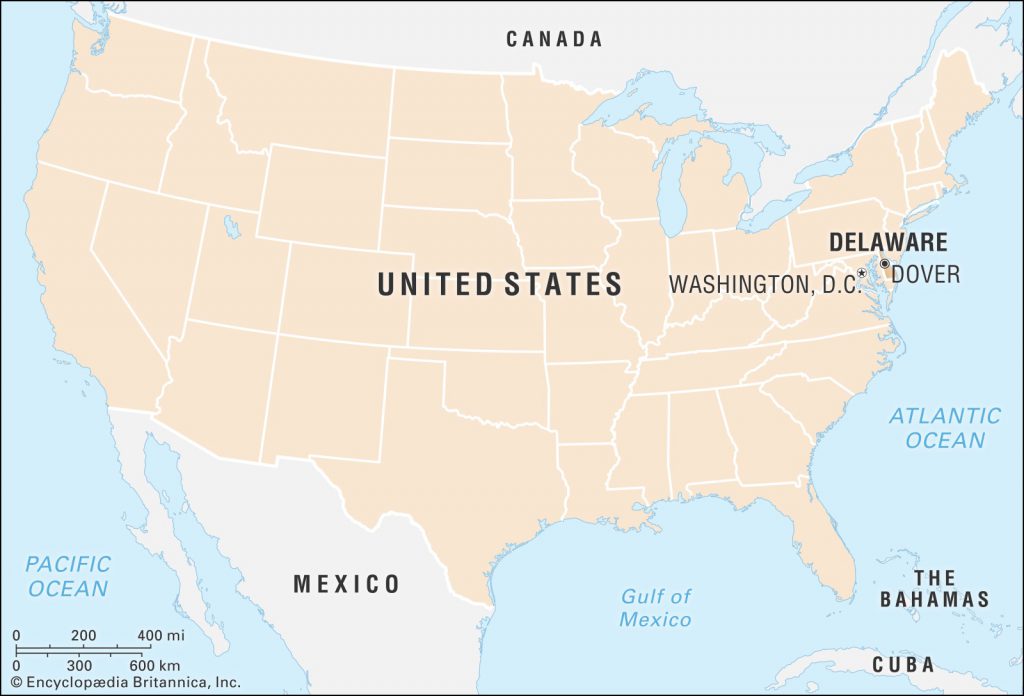
Hawaii PEV Laws
Minimum age: 15-18+
Registration requires an age of at least 18 years old. However, riders aged 15+ may operate an eBike if registered to a household or family member. Those under the age of 16 must wear a helmet.
eBikes: Legal.
Classified as “low-speed electric bicycles”, eBikes remain limited to a maximum speed of 20 mp/h. Hawaii is one of the only states that do not restrict where eBikes can be used, allowing them to use roadsides, highways, bike paths, sidewalks and more. However, bikers must register their ride before use, as required by Hawaiian law.
eScooters/eBoards: Legal, limited.
Both electric skateboards and scooters alike see classification as “toy devices”, remaining suitable for use on the sidewalk. Interestingly, they retain all the rights as normal pedestrians. Read the official Hawaii State definition for these models. Worth noting, some electric scooters fall under the EPAMD classification, with their restrictions detailed below.
Hoverboards: Unspecified.
Hoverboards likely see regulation under ‘EPAMD’ classification. Read 291C-134.5 of Hawaiian State legislation for their definition of EPAMDs. Moreover, we recommend checking your regional laws, as local governing bodies may set their own restrictions. Learn about the official stance of these hoverboards in public parks.

Kansas PEV Laws
Minimum age: Unspecified.
Although usually enforced under local jurisdiction, riders under the age of 18 must wear a helmet.
eBikes: Legal.
KS is one of 6 states to cap motor output to no more than 1000W and a maximum speed of 20 mp/h without pedal assist. Bikers have access to the majority of city streets and bike lanes, although remain prohibited from use on highways and interstates. No licensing, registration or insurance is required to ride in this state. Read more about Kansas eBike laws here.
eScooters: Legal.
New laws are currently being drafted for electric scooters and skateboards alike. eScooters see definition under the same section as bicycles and as such, must follow the relevant rules of the road. Although not fully enforced yet, the state encourages riders to wear a helmet throughout. Riders must also possess a valid driver’s license in order to legally use their scooter. Learn about Kansas eScooter laws in greater detail here.
Hoverboards: Unspecified.
The status of these PLEV models remains contested, although they likely fall under ‘EPAMD’ classification. This is also one of the few states in which students can use hoverboards on campus and city sidewalks without issue.
eBoards: Unlegislated.
These models remain classified as a “novelty” and lack any significant legislation. However, Kansas State governance is starting to look into these methods of transport a little more seriously. We recommend riding sensibly and in accordance with road laws, checking for any regional restrictions beforehand.
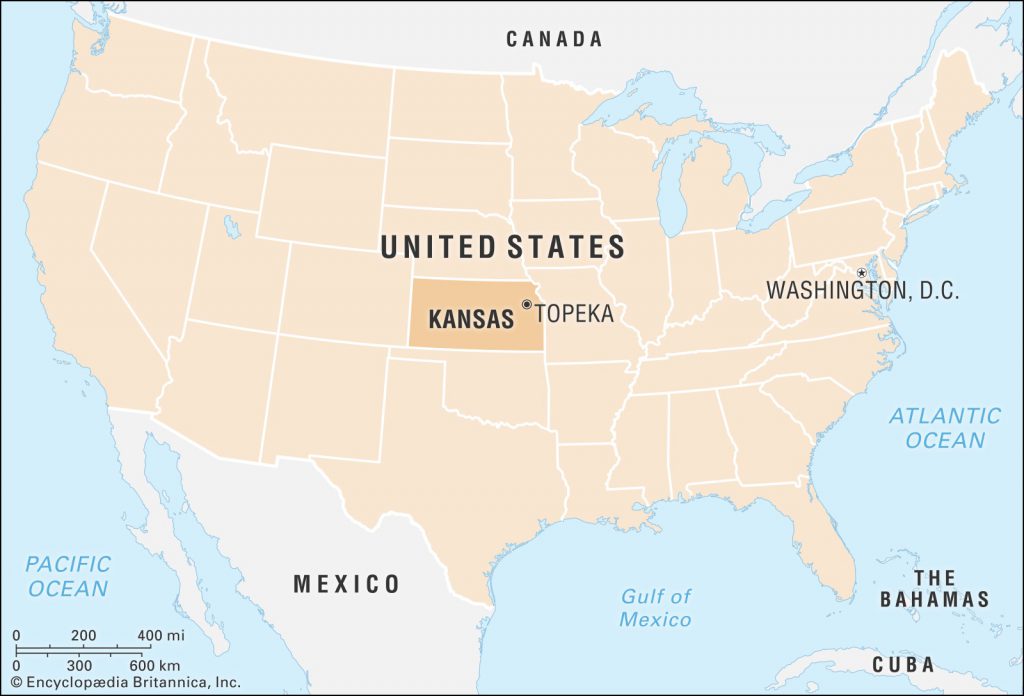
Kentucky PEV Laws
Minimum age: 16+
Riders under 16 must apply for a permit. Helmets must be worn by any rider under the age of 21.
eBikes: Legal.
Kentucky state defines eBikes as “mopeds” and regulates them accordingly. Electric bike models may not exceed 50cc or speeds over 30 mp/h, alongside no clutching requirements to the rider. As previously mentioned, those under the age of 16 require an instruction permit to legally ride. Bikers may use any roadway where the speed limit is less than the model’s maximum output (30 mp/h). Read the full Kentucky State Legislature here.
eScooters/eBoards: Legal.
Under Kentucky House Bill 258, electric scooters and skateboards alike see recognition as “motor scooters”. This bill affords them all the rights as bicycles, extending public access to highways, bike paths and bike lanes; even allowing their use on some highways, where they are viewed as motorcycles. To ride on the highway, riders must have insurance, a valid driver’s license, wear a helmet and possess adequate lighting.
Hoverboards: Unspecified.
Although we found no mention of hoverboards under Kentucky legislation, they are likely classified as EPAMD’s. However, we still recommend checking any regulations set by your local governing body.

Louisiana PEV Laws
Minimum age: 15+
Helmets are required for riders under 18 years old. Anyone under 18 not wearing a helmet must instead have health insurance, with proof available for law enforcement on request.
eBikes: Legal.
Louisiana state defines eBikes as a motorised bicycle possessing human-powered pedals and an electric motor no more than 50cc; alongside a speed limit no more than 25 mp/h. Provided the model is below 5 brake horsepower, no licensing or registration is required. §190. of RS 32:190 State Legislature contains everything there is to know about operating a bicycle in Louisiana.
eScooters: Legal.
These PLEV models see definition under ‘SB91 Act 258‘, allowing eScooters to utilise highways, bike lanes and even sidewalks, excluding business districts and parishes. Riders under the age of 17 must wear a helmet and incorporate adequate front, rear and reflective lighting. When used on the highway, riders have the same rights and responsibilities as a traditional motor vehicle.
eBoards: Unregulated.
Currently lacking any legislation. As such, eBoards likely see regulation on a municipal level, so check your local laws first before riding!
Hoverboards: Legal.
Under §300.2. of RS 32:300:2, EPAMDs are defined in the traditional sense; self-balancing with two non-tandem wheels, designed to transport one person at no more than 25 mp/h. It also grants access to utilise sidewalks, bike paths and even highways (with speed limits below 25 mp/h).

Massachusetts PEV Laws
Minimum age: 16+
Helmet required for all ages.
eBikes: Legal.
Electric bike models remain classed as “motorised bicycles”, provided they do not exceed speeds of 25 mp/h. Despite this, riders must still possess a valid license and may require registration, depending on your region. Bikers have access to all public ways, excluding state highways and areas that prohibit bicycles. Any eBike that exceeds 50cc or a 30 mp/h speed limit is considered a “moped” by law.
eScooters: Unregulated.
These models currently lack any significant legislation. Currently defined as “motorised scooters“, riders must possess a valid driver’s license in order to ride legally. They are also expected to follow local traffic laws, treated as a road vehicle in all circumstances yet not requiring insurance.
Hoverboards: Legal.
Under Bill H.3278, traditional hoverboards are classified as EPAMDs. This definition extends to a number of PLEV models, although the same basic requirements remain:
- Riders must be 16 years old or over
- Always yield right-of-way to foot pedestrians
- Always ride in a single file line
- Exceed no more than 12.5 mp/h
- Transport no more than one person
- Possess no more than two non-tandem wheels
eBoards: Unregulated.
We were unable to find any state legislation surrounding electric skateboards. As such, these eBoards likely see regulation on a municipal or local level. As such, please check your regional laws to ensure they’re allowed in your area first.
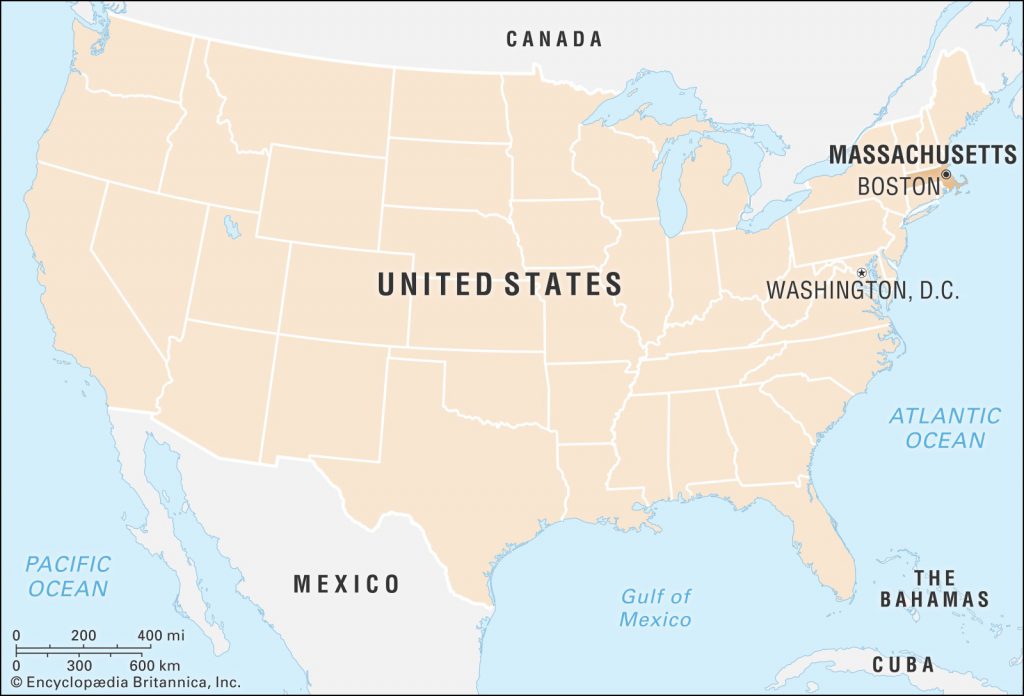
Montana PEV Laws
Minimum age: Unspecified.
No helmet requirements.
eBikes: Legal.
Under 61-8-102, MCA of Montana Law, eBikes must possess two operational pedals and an attached motor. It must have the capacity to propel riders of up to 170 lbs to speeds of 20 mp/h, and no faster. Bikers freely have access to roadways and bike paths, with no licensing, insurance or registration is required.
eScooters/eBoards: Restricted.
Electric scooters and skateboards both see categorisation as “motorized non-standard vehicles” and remain unsuitable for use on roadways or sidewalks. Whilst each city may override these laws, there are very few towns that actually have.
Hoverboards: Unspecified.
Whilst we found no legislation surrounding these PLEV models, an article from March 2020 details Montana State’s plan to ban eScooters and hoverboards alike from pedestrian areas. As such, please check your local laws for any regional restrictions and ensure you’re riding legally.



Minnesota PEV Laws
Minimum age: 15+
No helmet requirements.
eBikes: Legal.
Under Minnesota Statute 169.011 (Subdiv. 47), these models are classified as an “electric-assisted bicycle”, incorporating pedals and a motor with a speed no faster than 20 mp/h. Under this definition, eBikes in Minnesota are still considered bicycles. These models remain suitable for use on hard shoulders, bicycle trails/paths, lanes and the roadside, with no insurance, licensing or registration requirements. Minnesota is also one of six states to allow for a maximum output of 1000W.
eScooters/eBoards: Legal.
Both electric scooters and skateboards fall under the same “motorized foot scooter” classifications. Riders are expected to operate similarly to bicycles, remaining restricted from the sidewalk under “MN 169.225” and must be at least 12 years of age. adequate front and rear lighting is another requirement, alongside a maximum speed of 15 mp/h. Riders under the age of 18 are advised to wear a helmet.
Hoverboards: Legal.
Minnesota law classifies hoverboards as “low-power and unconventional vehicles”, consequently falling under the ‘EPAMD’ category. Hoverboard models must only transport one person, use an electric motor and operate no faster than 15 mp/h.



Mississippi PEV Laws
Minimum age: Unspecified.
No helmet requirements.
eBikes: Unregulated.
Mississippi is one of the few states that do not legally define eBikes. As such, riders should check their local laws to ensure their region accommodates such vehicles. Read more about riding eBikes in Mississippi here.
eScooters/eBoards: Unregulated.
Both electric skateboards and scooters remain unregulated or even specified by Mississippi law. Proposed bills for the future intend to regulate them the same as bikes, whilst also encouraging helmet use. In the meantime, check the rules of your local jurisdiction before riding!
Hoverboards: Unspecified.
We were unable to find any regulations or legislation surrounding these PLEV models. However, they remain banned from all residence halls and buildings on the State University campus. Like the rest on this list, check your local laws first!



New Jersey PEV Laws
Minimum age: 15+
Riders under 17 must wear a helmet for all models.
eBikes: Legal.
New Jersey law limits eBikes to a maximum motor output of 750W/50cc and a speed limit of 25 mp/h on flat ground. This is one of few states to require licensing/registration of eBikes, with riders requiring a basic, moped or motorcycle license. Electric bikes remain suitable for use on roadways, bike paths/lanes and even on the sidewalk, with riders required to yield to all pedestrian traffic. Interstate highways, railways and any road with a speed limit of 50 mp/h remain banned from use at all times.
eScooters: Legal.
Under NJ SB 731, electric scooters are regulated the same as bicycles, granting access to bike paths and lanes. This legislation dictates a maximum speed limit of 20 mp/h (32 km/h).
Hoverboards: Restricted.
According to a Camden criminal lawyer, these PLEV models see classification under the term ‘motorised scooters’. New Jersey traffic laws prohibit such motorised scooters/hoverboards from public paths and roadways, alongside being banned from a number of schools and universities.
eBoards: Legal.
Electric skateboard models were supposedly banned under New Jersey law, although we could not find any evidence of this. In fact, other sources state that nothing in the law prohibits the use of EPAMD’s. Please check the local laws for your region to ensure you don’t break any municipal laws or restrictions.



Nebraska PEV Laws
Minimum age: Unspecified.
No helmet restrictions.
eBikes: Legal.
Nebraska state defines an electric bike as any bicycle propelled via pedalling or an electric motor, with a maximum output of 750W and speed of 20 mp/h. Although eBikes see inclusion in state-run educational/safety programs, no licensing, registration, insurance or even a helmet is required to ride. Bikers have access to most roadways, bicycle lanes and paths unless notified otherwise. Adequate front & rear lighting is required to legally ride at night, with reflective material on both sides.
eScooters/eBoards: Legal.
Electric scooters and skateboards both fall under the definition of “micro-mobility vehicles” and remain free from any significant restrictions, regulations or registration requirements. Riders are expected to abide by the rules of the road and stay in the bike lane, with the use of any sidewalks prohibited. Learn the legalities of each state in this in-depth survey of laws by law firm ‘Morgan Lewis’.
Hoverboards: Legal.
Under LB 976 of Nebraska state legislature, hoverboards are classified as EPAMD’s. Such models are defined as self-balancing with two non-tandem wheels. However, local jurisdictions may still supersede state law, so double-check for your region before riding!



North Carolina PEV Laws
Minimum age: 16+
Helmet required for riders under 16.
eBikes: Legal.
NCDOT defines eBikes as bicycles with a small motor for assistance, with a max. output of 750W and a top speed of 25 mp/h on flat surfaces. Bikers have access to all public highways, roadways, sidewalks, bike lanes and paths, provided the speed limit is under 25 mp/h. Riders must yield any right-of-way to pedestrians, alongside equipping their eBike with adequate front/rear lighting when riding at night. No registration, licensing or insurance is required.
eScooters/eBoards: Varied.
Both electric scooters and skateboards do not possess any specific legislation. Instead, municipalities and other local jurisdictions have the freedom to enact their own regulations for these models. As such, rules heavily vary depending on which city you live in, so please read any regulations for your region before riding in public.
Hoverboards: Legal.
These models are classified as EPAMDs, provided they incorporate self-balancing, two non-tandem wheels and have a speed limit below 15 mp/h. Such hoverboards and Segways have access to sidewalks, bike paths and roads with speed limits below 25 mp/h. No helmet or licensing is required, although riders must have liability insurance and officially register their ride.



North Dakota PEV Laws
Minimum age: 14+
Helmet requirements for riders under the age of 18.
eBikes: Legal.
State governance defines an electric bike as a device with 2-3 wheels no more than 32″ wide, a max. motor output below 500W and a top speed of 30 mp/h. Whilst they have access to all public highways and roadways, eBikes in North Dakota still do not require any registration or licensing. Like most other states, these regulations may be superseded by municipal law, so please check the requirements for your region first.
eScooters: Legal.
Electric scooters remain defined as “motorised scooters”. As such, they are limited to a top speed of 30 mp/h and require valid licensing to ride, alongside a minimum age of at least 14 years. Riders must wear a helmet at all times and are prohibited from using bike paths and sidewalks. Lastly, eScooter models must incorporate front/rear lighting and adequate brakes.
Hoverboards: Legal.
Under § 12-09-43 of N.D. Code (Title 12), traditional hoverboards see classification as EPAMDs. As a result, riders have access to public sidewalks and a limited number of lanes. Read North Dakota’s official definition of EMPADs directly from N.D. Traffic Code here.
eBoards: Unregulated.
Unregulated by state governance. Riders must abide by municipal/local regulations instead. Please comment and let us know if we have missed anything.



Nevada PEV Laws
Minimum age: Unspecified.
Local helmet requirements only.
eBikes: Legal.
Classified as any two or three-wheeled device with an automatic transmission and a maximum motor output below 750W. eBike models must not exceed 20 mp/h on level ground, with helmets required for all riders. Bikers have access to all public roadways and bike lanes, provided the speed limit is below 20 mp/h. No licensing, registration or insurance requirements. Read the Nevada Department of Transportation’s stance on eBikes here.
eScooters/eBoards: Legal.
Under Bill AB485, electric scooter and skateboard users must be aged at least 16+ years old, with cities and municipalities setting laws and regulations as they see fit. For example, Las Vegas bans all ‘micro mobility’ devices from use within the city, so please check your regional regulations first!
Hoverboards: Restricted.
Under government guidelines, hoverboards are seen as “powered transporters” and thus motor vehicles. They remain prohibited on public roads and pedestrian areas such as sidewalks and bike lanes. Whilst these strict regulations may change in the future, riders can currently only use these devices on private property. Learn more about these restrictions in greater detail.



Oregon PEV Laws
Minimum age: 16+
Helmet required for riders under the minimum age.
eBikes: Legal.
Oregon is one of the six states to cap the maximum motor output of eBikes at 1000W, as opposed to the standard 750W commonly seen. Despite this, their top speeds remain limited to the same 20 mp/h. Under the Oregon Vehicle Code, eBikes are viewed as bicycles and have full access to any roadway, lane or path previously approved for bicycles. Use of any sidewalks still remains prohibited, alongside some Oregon State Parks viewing these as “motorised vehicles” and subsequently banning their use; should they not meet the parameters defined in the ORS 801.258 code.
eScooters: Legal.
The Oregon Department of Transport guide shows specific rules for electric scooters, limiting their use to bike lanes only and prohibiting speeds above 15 mp/h (24 km/h). These regulations retain the same maximum motor output as eBikes, capped at 1000W. Riders must be at least 16 years old and are encouraged to wear a helmet.
Hoverboards: Legal.
These models see classification as EPAMD’s and must not exceed speeds of 15 mp/h. Under ORS 807.020, they are not defined as motor vehicles and do not require any licensing; although riders must be at least 16+ years old. Depending on the region, these EPAMD’s fall under bicycle laws or pedestrian laws. In most regions, they must yield the right of way to any pedestrian they encounter, alongside not operating their hoverboard in a careless manner on the sidewalk. Read more about this Oregon hoverboard law here.
eBoards: Legal.
According to DuBois Law Group (Portland attorneys), there are no specific regulations surrounding eBoards. Skateboarders are considered pedestrians and as such, are permitted to ride anywhere, although with some local limitations. Please check any relevant local laws set by the governing body of your region before riding.



Pennsylvania PEV Laws
Minimum age: 16+
No helmet requirements.
eBikes: Legal.
According to Pennsylvania regulation, electric bikes must possess a maximum motor output of 750W/50cc, automatic transmission and a maximum speed of 25 mp/h. Currently, these models have access to sidewalks and most roads, although we found little regarding access to bike lanes. We recommend reading through the DMV website for more information. No licensing or registration requirements.
eScooters: Restricted.
Legislation for eScooters and other ‘micro mobility’ products have recently entered development. Should this pass, eScooter models will see the same treatment as bicycles. Currently, eScooters remain banned from use on sidewalks/roads, with a minimum rider age of at least 16 years. See the full Pennsylvania DVS document here.
Hoverboards: Legal.
Defined under Section 102 of the Pennsylvania Vehicle Code, these models see classification as EPAMDs. As such, they must incorporate self-balancing, two non-tandem wheels and carry only one person. As such, hoverboards remain legal to use on sidewalks and roadways, unless prohibited by local law.
eBoards: Legal.
Although there is a clear lack of legislation surrounding skateboards, they seem to follow the same restrictions as eBikes regarding their motor wattage and power. As such, electric skateboards must not exceed 20 mp/h or possess a motor with a maximum output greater than 750W. Although the following regulations are regional, Chapter 256 of the City of Lancaster gives some insight into the stance on skateboards. Please check your local laws or legislation before riding in public.



Rhode Island PEV Laws
Minimum age: Unspecified.
Under § 31-19-2.1. of RI vehicle legislation, any rider under the age of 15 is required to wear a helmet.
eBikes: Legal.
Electric bikes are classified as “motorised bicycles” and are defined as two-wheel vehicles propelled by human output or electric motors. These motors must not exceed a 4.9 horsepower rating, be greater than 50 cc or reach a maximum speed above 30 mp/h. This is already a sizable increase in comparison to other states, whilst also allowing for a maximum motor output of 1491W. Riders do not require licensing or registration, although liability insurance is recommended. Visit the RI DMV website for more information.
eScooters: Legal.
RI state governance recently introduced a pilot program for eScooters. However, riders must still possess valid driver’s licenses and should always wear a helmet. As a result of this, electric scooters have access to sidewalks and streets; although we still recommend checking your local municipal laws first.
Hoverboards: Legal.
Under § 31-19-3 of 2012 Rhode Island General Laws, hoverboards fall under the definition of an ‘EPAMD’. As a result, riders possess all the rights and obligations of a pedestrian, although local jurisdictions may have passed their own rules and regulations. Please check your local laws before riding!
eBoards: Legal.
Electric skateboards remain listed as “motor vehicles” under sections 31-1-3.(g) and 31-1-3.(s) of the RIGL; with riders expected to abide by the same rules and regulations.



South Carolina PEV Laws
Minimum age: Unspecified.
No helmet requirements, as eBikes/PLEVs are currently defined as “motor vehicles”. Standard pedal-powered bicycle riders younger than 18 must wear a helmet.
eBikes: Unregulated.
Although not yet officially classified, electric bikes are considered vehicles and should follow standard road rules. No licensing or registration is required, provided the eBike motor output does not exceed 750W. Models that exceed this limit are considered “mopeds”, requiring relevant licensing and registration. ‘Title 56’ of S.C. Code of Laws contains all state legislation regarding motor vehicles.
eScooters: Unregulated.
Motor outputs should not exceed 750W and riders must follow the rules of the road, as these models are still viewed as vehicles. Cities and other local jurisdictions have the authority to override these laws if required, so check the laws for your region first.
Hoverboards: Unregulated.
Although little information is available for hoverboards directly, they likely see classification as EPAMDs. S.C. Code § 56-5-3310 contains everything there is to know about how these electric vehicles are both defined and regulated. Again, always check your municipal laws beforehand.
eBoards: Unregulated.
Due to lacking regulation or even any specific definition, electric skateboards remain subject to local jurisdiction. Learn more about the stance on motorised boards here.
Vermont PEV Laws
Minimum age: Unspecified (16+ to ride on highways)
Helmet requirements for riders under 16 years old.
eBikes: Legal.
Classified as “motor-assisted bicycles“, eBikers find their rides regulated the same as traditional bicycles, provided they possess operable pedals. Motors are limited to a maximum output of 1000W and may operate at speeds no higher than 20 mp/h. No licensing or registration is required, although liability insurance is recommended. eBikes have access to bike paths and other roadways, however, riders under the age of 16 cannot utilise highways.
eScooters/eBoards: Unregulated.
As it stands, both electric scooters and skateboards lack clear legislation. Instead, regulating these rides is done on a municipal level, so please double-check the local laws for your region beforehand.
Hoverboards: Unspecified.
Title 23 of Vermont Statutes contains all the necessary information for operating a motorised vehicle/EPAMD. State legislation does not define EPAMDs in the traditional sense (with two non-tandem wheels, etc.). Read § 1141a of Title 23 for their full definition and stance on EPAMDs.



Undefined Regions & Territories
Five states/overseas territories have taken no official stance on PLEVs and eBikes, remaining undefined and unregulated in the following regions:
American Samoa PEV Laws
Information for this region remains highly limited, with their government making no statements regarding eBikes or any other PLEV models. Please leave a comment and let us know of any information you think we’ve missed.



Guam PEV Laws
Although PLEV information is very limited for Guam, feel free to read through their somewhat outdated ‘Bicycle Safety Act of 2012’ for more insight. According to Guam law, all two-wheeled motors (including mopeds/scooters over 50cc) must have correct licensing and insurance. We are unable to find any official government definition of “moped”, however, this typically means any scooter over 50cc/750W. Please let us know if you think we’ve missed anything for this region.



New Mexico PEV Laws
Minimum age: Unspecified.
Helmets requirements for riders under 14 years old.
eBikes: Unregulated.
Currently, eBikes are regulated the same as normal bicycles. As such, no licensing, registration or insurance is required. Please check your local laws first before riding. Read through the 2015 New Mexico Statutes to learn about motor vehicle laws.
eScooters/eBoards: Unregulated.
Much like eBikes, electric scooters and skateboards remain unregulated by state governance. Instead, riders must abide by municipal or other local jurisdictions. Currently, eScooters/eBoards remain prohibited from using the sidewalk or any public walkways. Please check your regional laws before riding.
Hoverboards: Unknown.
We were unable to find any legislation surrounding these models. It appears that they do not even define these as EPAMDs, with no official classification available. Please check your local laws beforehand to ensure they’re not banned from your area.



Northern Mariana Islands PEV Laws
Updated legislation for this region remains rare. The only stance we could find regarding any PLEV model was from H.B. No. 15-17, enacted as the “Motor Scooter Act of 2006”. This Act contains their official definition of an electric/motorised scooter, alongside other vehicular regulations.



U.S Virgin Islands PEV Laws
Currently, the only legislation relating to PLEV models is from the ‘2019 US Virgin Islands Code’. Under § 465a, they discuss a “pocket bike”, a non-highway vehicle resembling a mini-motorcycle. Whilst traditional designs for these “pocket bikes” do not resemble modern electric bikes, this definition/legislation may extend to them nonetheless. We recommend reading through the 2019 US V.I. Code, including Section § 465, regarding motor vehicles.



Conclusion
Thanks for reading our complete guide to PEV and eBike law in the United States. We hope to have answered all of your questions. If not, check out our FAQ section below for some more answers, or leave us a comment and we’ll get back to you. In the meantime, learn the latest PEV news, or read through some of our in-depth eBike reviews here!
Frequently Asked Questions
Which states don’t require helmets?
Alaska, Arizona, Idaho, Missouri, Utah, Wyoming, Kansas, Montana, Minnesota, Mississippi, Nebraska, Nevada, Pennsylvania, South Carolina currently do not require helmets to legally ride.
What states enforce PLEV registration?
Alaska, Connecticut, Georgia, Hawaii, Massachusetts, New Jersey, North Carolina.
Which states require licensing?
Alabama, Alaska, California, Connecticut, Illinois, Missouri, Oklahoma, North/South Dakota, Tennessee, Virginia, Kansas, Kentucky, Massachusetts, New Jersey, Rhode Island, South Carolina, Guam.
Which states impose motor power limitations?
7 states specifically allow eBikes to have a max power of 1000W; these are Georgia, Kansas, Minnesota, Oklahoma, Oregon, Vermont and Virginia.
23 states cap eBikes at a max power of 750W; these are; Alaska, Arkansas, California, Colorado, Delaware, Iowa, Indiana, Maine, Michigan, Missouri, Nevada, Nebraska, North & South Carolina, New Hampshire, New Jersey, Pennsylvania, Texas, Tennessee, Utah, Washington, Wyoming and Wisconsin.
4 states have their own unique limitations, Michigan (2500W), Utah (2000W), Rhode Island (1491W) and lastly, Delaware (759W).
Maryland and North Dakota share one of the strictest limits, at 500W. Only two states, Florida and Mississippi, currently have no max power limit for electric bikes.
Which states have unique classifications for eBikes?
Hawaii, Oregon, Nevada, Montana, Minnesota, Idaho, Nebraska, Kansas, Kentucky, Mississippi, North Carolina, South Carolina, Washington DC, Delaware, New Jersey, Pennsylvania, Rhode Island.
Sources and Additional Reading
- https://envyride.com/laws-and-legislation-electric-scooters/
- https://www.radpowerbikes.com/blogs/the-scenic-route/ebike-laws-around-the-world
- https://edriveplanet.com/guides/electric-scooter-and-skateboard-laws-in-america-all-states/
- https://www.therussellagency.com/blog/2020/01/electric-scooters-are-coming
- https://www.cga.ct.gov/2000/rpt/2000-R-0649
- https://evelo.com/blogs/ebike-laws/connecticut
- https://edriveplanet.com/guides/electric-scooter-and-skateboard-laws-in-america-all-states/
- https://helmets.org/ebikelaws.htm


